
“We know that other countries in response to one mass shooting have managed to craft laws that almost eliminate mass shootings. Friends of ours, allies of ours, Great Britain, Australia, countries like ours. So we know there are ways to prevent it.”President Obama, Oct. 1, 2015
Politics nowadays are dominated by what gets attention, because what gets attention spreads the fastest and furthest. This is the dark side of social media and 24/7 news, and one event in particular in the firearms world is ground zero for this phenomenon – mass shootings.
In the wake of a mass shooting, politicians who already dislike law-abiding Americans owning guns use the tragedy to push for additional gun laws, irrespective of the existing laws already broken. This is done when emotions are at their highest (and thus rational thinking at its lowest), usually under the auspices of enacting gun laws like those in the U.K. and Australia. President Obama’s former Chief of Staff Rahm Emanuel said it best:
“You never want a serious crisis to go to waste. And what I mean by that is an opportunity to do things you think you could not do before.”
Careful analysis of these countries’ gun control experiments actually depicts a more nuanced picture of gun policy and crime. In fact, there is reason to believe that gun control may have actually not had much of an impact on crime in either country – but this sort of critical thinking takes concerted effort, and who has time for such things when politics today are less about sound, long-term policy and more about sensationalizing another’s tragedy to advance your agenda?
Below is a guide to help American gun rights activists understand the history of gun registration and gun control efforts in the U.K. and Australia, the two countries which anti-gun politicians often cite as muses for their proposed laws.
Table of Contents
- Events That Led to Gun Laws in Australia
- Events That Led to Gun Laws in Great Britain
- Falling Crime Rates in the Western World
- The Effects of Gun Control in Australia
- The Effects of Gun Control in the U.K.
- New Zealand: An Addendum
- Follow the Red, White, and Blue
Events That Led to Gun Laws in Australia
On April 28, 1996, Australia experienced a national tragedy. A deranged murderer, Martin Bryant, went on a rampage and killed 35 people in cold blood. In response to this atrocity, known as the Port Arthur massacre, the Australian government undertook a heavy-handed gun control campaign. This included a mandatory buyback program where Australian citizens had to turn over 650,000 “assault weapons” to the government. This program was followed up by a subsequent buyback program in 2003.
At the center of Australia’s gun control policy following the Port Arthur massacre was the National Firearms Agreement of 1996. Although international media outlets portray the 1996 NFA as a ban, it was actually a draconian form of gun control that still allowed for gun ownership, albeit to a very limited degree. The only real bans that took place were ones targeting so-called “assault weapons” – long-guns such as rifles and shotguns. Handguns were still accessible to the public but were subject to stiff restrictions.
Events That Led to Gun Laws in Great Britain
Britain’s first gun control package passed in the modern era was the Firearms Act of 1920. Fearing a growing wave of unrest in the aftermath of World War I, British politicians passed this gun control law despite scant evidence showing that crime was on the rise during that time period.
The Firearms Act of 1920 was only the beginning – as the 20th century was a time of progressive government growth in all facets of life, and the U.K. was no exception. After the enactment of the Firearms Act of 1920, the British government passed gradually stricter laws in 1937, 1968, and 1988. Despite having comprehensive gun control at the national level, the homicide rate in Great Britain slowly grew from the 1950s into early 2005.
When it came to mass shootings, British gun control efforts proved futile. Shooting rampages in Hungerford, England, and Dunblane, Scotland received international attention, which put the island nation at a major public policy crossroads. Like its Australian counterpart, the United Kingdom opted for stiffer gun control.
After the Hungerford massacre, the government responded with the passage of the Firearms Act of 1988, a new gun control measure that placed draconian restrictions on rifles and shotguns. The Dunblane massacre prompted the British government to ban the possession of handguns by passing the Firearms Act of 1997.
Falling Crime Rates in the Western World
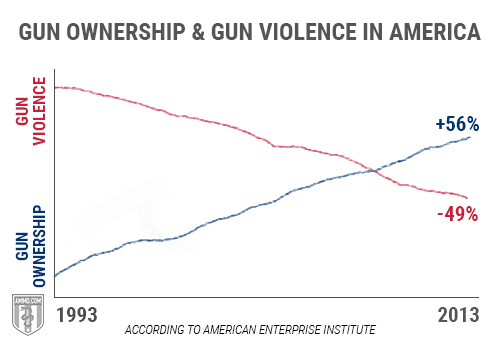
Arguably the most popular example of foreign gun control, advocates of tougher gun laws routinely cite Australia and its 1996 NFA law as an example of gun control causing crime to fall. Although Australia is a nation characterized by a low degree of crime, there’s more to Australia’s low crime rates than gun control.
Homicide rates have been declining across Western Europe, Canada, and the U.S. since the 1990s. Australia was not exempt from this trend, and in fact, Australia’s falling crime was essentially the norm for industrialized countries in the West. Homicides were already a rare occurrence before the passage of the 1996 NFA. In sum, we can barely learn anything meaningful from slight changes in Australian homicide rates around this time.
In Why Crime Rates Are Falling Throughout the Western World, Michael Tonry argues the following:
“There is now general agreement, at least for developed English-speaking countries and western Europe, that homicide patterns have moved in parallel since the 1950s. The precise timing of the declines has varied, but the common pattern is apparent. Homicide rates increased substantially from various dates in the 1960s, peaked in the early 1990s or slightly later, and have since fallen substantially.”
This same trend of declining violence was on display in the United States. American homicide rates reached a 51-year low in 2014. During this time period, there wasn’t a gun control measure as comprehensive as Australia’s NFA in America that we can point to in explaining this decline. In fact, American gun ownership per capita increased by 56 percent from 1993 to 2013. This was accompanied by a gun violence decrease of 49 percent. Correlation is not causation, but this goes to show the explanations behind crime rates are complex and are not necessarily about passing a so-called gun control “fix.”
The Effects of Gun Control in Australia

According to gun researcher John Lott, homicide rates in Australia have been on a downtrend since 1969. During this timeframe, the only time homicide rates increased was from 1998 to 1999, not long after the NFA was passed. However, Ryan McMaken argues that Australian crime data is very spotty. He contends that the data is not very reliable because crime was such a non-issue that the government did not prioritize recording it. McMaken provides further context:
“Australia is a small country, with only a few more million people than Florida, spread out over an entire continent. In the relatively high homicide days of the early 1990s, Australia’s homicides totaled around 300. This means in a bad crime year, in which homicides increase by only 20 or 30 victims, it could swing overall rates noticeably.”
All in all, what we can gather is that Australia had low crime rates well before the passage of the 1996 NFA. However, this is one part of the story.
Australia’s gun buyback program from 1996 to 1997 was able to reduce the supply of firearms from 3.2 million 2.2 million, but the declines in homicide or suicide rates were not as high as many gun control advocates expected.
Interestingly enough, Australia’s gun buyback did not even stifle civilian gun ownership. In 2010, private gun ownership was back to 1996 levels. Plus, data from 1997 to the present day show that gun ownership in Australia has actually grown three times faster than the population. The total number of firearms in circulation went from 2.5 million to 5.8 million.
Gun control advocates maintain that the more guns present, the more likely crime rates will skyrocket. Crime rates were already low before gun control came into being and continued to fall even after gun control was implemented. Moreover, Australia still experienced an increase in the number of guns in the country despite the gun control laws in effect.
Indeed, it’s hard to place what factors exactly contributed to Australia’s decreasing homicide rates. It’s simplistic to believe that gun control is the missing x-factor in lowering crime. Additionally, the Australian experience shows that Australia’s decision to not completely ban gun ownership has given some law-abiding gun owners a little bit of flexibility in acquiring firearms.
The Australian gun control case actually looks quite bleak when compared to the U.S.’s higher degree of gun rights over the past few decades. From 1995 to 2006 – a time when firearm ownership was reduced – Australia witnessed a significant increase in rapes and sexual assaults. In 400 Years of Gun Control, author Howard Nemerov specifically pointed to numbers indicating a 21.4 percent increase in rape and sexual assault rates during this period.
On the other hand, America saw increased gun ownership during this time, so it’s no surprise they fared better when it came to sexual assaults, which fell by 16.8 percent. Gun ownership tends to benefit the most vulnerable in society, like women and the elderly, who are often overpowered in violent assaults by criminals who rely on brute strength. With guns entering the equation, the playing field is ultimately leveled.
All in all, gun control down under is not what it seems.
The Effects of Gun Control in the U.K.
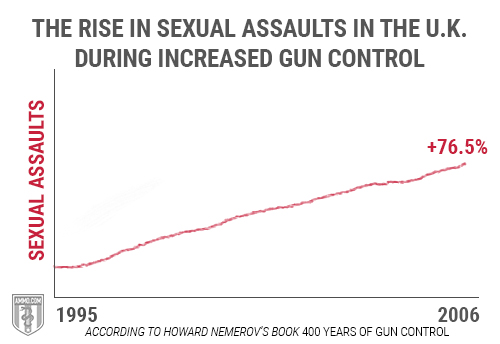
Like Australia, low homicide rates have been generally the norm in recent British history. At the beginning of the 20th century, England and Wales were already some of the safest countries in the world based on global and historical standards.
At first glance, the gun control measures appeared to coincide with decreases in Britain’s homicide rates, which started taking place after 2002. However, there is reason to believe that there were other factors contributing to Britain’s falling crime rates during that period. John Lott argues that increased policing in the U.K. is a more plausible explanation for this drop around the early 2000s.
Although Lott recognizes that the police play a crucial role in fighting crime, his research over the years has led him to the conclusion that the police can’t always be at crime scenes to save lives. They usually end up at the crime scene after the fact, thus demonstrating the need for other security options at our disposal. An increased law enforcement presence eventually hits a point of diminishing returns as witnessed in the U.K. during the mid-2000s. Despite a substantial increase in the police force, the murder rate was still above the pre-handgun ban rate.
Gun control advocates remain steadfast in their belief that gun control was solely responsible for the fall in murders after 2002. Even if we concede ground on this point, we also have to ask why gun control was not at fault for the repeated increases in murder rates from the 1960s until the 1990s – a time when homicide gradually increased despite new gun control legislation being passed throughout those decades.
We must also keep in mind that statistical figures in the U.K. should be viewed with a certain degree of skepticism given the differences in the way crimes are accounted for. Starting in 1967, homicide figures in England and Wales exclude cases that don’t result in convictions. Put simply, when no arrest for a homicide is made, which in turn results in no conviction for the murderer, the murder is not accounted for in statistical figures.
The U.S. has a different approach to recording homicide statistics – including cases that did not result in murder convictions. For example, deaths caused by defensive gun use as well as unsolved cases would be classified as homicides in the U.S.
This makes crime rate comparisons between countries like the U.S. and the U.K. rather tricky. When adding gun control laws and their effects on crime rates into these comparisons, the picture becomes murkier. Confounding variables abound which can lead to flawed interpretations of these events. Recent data show that the U.K.’s gun control experiments are actually causing more harm than good. Like its Australian counterpart, which also implemented draconian gun control in the 1990s, negative criminal trends have started to surface since new gun control laws were enacted.
Sexual assaults have seen an alarming rise from 1995 to 2006, specifically increasing by 76.5 percent according to Howard Nemerov’s book 400 Years of Gun Control. All the gun control in the world has not been able to save the U.K. from steadily increasing rates of violent crime.
One particularly interesting detail about crime under the country’s gun control regime is that criminals have now changed the tools they use to carry out their dirty deeds. Specifically, British criminals are using knives to commit crimes.
The Guardian reported on the recent knife crime wave sweeping across the U.K.:
“Police recorded 39,598 offences involving a knife or sharp instrument in the year to December 2017, a 22% increase compared with the previous year (32,468), and the highest number registered since comparable records started in 2010. Gun crime rose to 6,604 offences.”
The London Metropolitan Police reports that teenagers commit 49 percent of knife crime. On top of that, three-quarters of stabbings were committed by minorities. Breitbart also gave a lurid depiction of London’s ongoing knife rampage:
“London specifically experienced record high knife crime, increasing by 15 percent to a total of 14,987 blade offences – representing 38 percent of all knife crimes across England and Wales and averaging 41 knife crimes a day.”
With questionable immigration policies that prevent assimilation and an environment that does not protect law-abiding Britons’ right to self-defense, the U.K. risks sliding into social chaos.
Sadly, British politicians still believe more government control is the answer to this problem. In the face of this stabbing epidemic, London Mayor Sadiq Khan has advocated for knife control. One Member of Parliament Scott Mann has even floated the idea of embedding GPS trackers on all knives sold in London.
Instead of considering alternatives like tougher policing in crime-ridden neighborhoods or even arming their citizens, elected officials in London have created a de facto surveillance state. A report from WorldAtlas uncovered that London is the most surveilled city in the world with an estimated 51,000 cameras used to snoop on London residents.
New Zealand: An Addendum
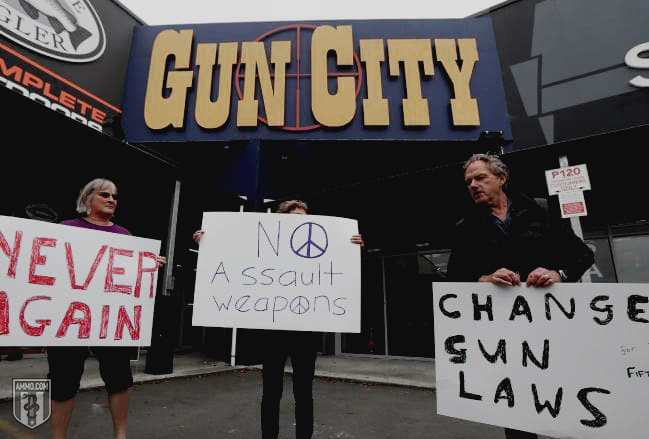
On March 15, 2019, New Zealand faced its own Port Arthur incident. A 28-year-old Australian citizen by the name of Brenton Tarrant opened fire on two mosques in Christchurch, leaving 50 people dead. The shocking nature of this massacre had media talking heads around the world on edge for the next week
In an already polarized environment in western countries, where identity politics have a strong pull, politicians were quick to make their pro-gun control stances heard. From Alexandria-Ocasio Cortez to Bernie Sanders, U.S. members of the Democratic Party have made their calls for gun control clear. Universal background checks and so-called “assault weapons” bans are now on the table.
There is no question this event was a horrific tragedy and the atrocious nature of the incident will forever rock New Zealand’s public conscious. That being said, analyzing this incident and figuring out how to go from there requires level-headed thinking. Much to the dismay of pro-gun advocates who want to see their countries expand gun rights, emotion tends to reign supreme in all public policy discussions.
As with the Australian and British cases, we find that New Zealand has also witnessed the same declining crime rates trend the rest of the West has experienced in the past few decades. In 2014, New Zealand’s homicide rate stood at 0.9 per 100,000 people. Particularly curious, New Zealand hit a 40-year low in its murder rates in 2017 – with only 35 people being killed in the country. Murders peaked in the 1980s, with 1986 being the year with the highest total of murders, standing at 79.
It should be noted that New Zealand does feature pretty strict gun control. Gunpolicy.org notes that in New Zealand, “the right to private gun ownership is not guaranteed by law,” which is a stark contrast from the U.S. – which nominally recognizes it as a right. Prospective gun owners in New Zealand must have a license before buying a gun. Then, they must go through a universal background check of sorts that “considers criminal, mental health, medical, addiction, and domestic violence records.”
Following the Mosque shootings, Prime Minister Jacinda Ardern immediately called for bans on semi-automatic weapons and “military-style” variants. She got her wish a few days after the shooting, with a new ban on “assault weapons.” Despite the New Zealand government’s push for gun owners to turn in their firearms in the wake of the mass shooting, a paltry number of firearms have been turned in so far.
Like Australia, we cannot assume with certainty that gun control has been the primary driver of New Zealand’s already low crime rates. The effects of New Zealand’s new gun control laws will be an interesting case study nonetheless.
But with the American counterexample showing how crime rates can still decrease, even with certain jurisdictions liberalizing gun laws, we must call into question the conventional wisdom that gun control is the alpha and the omega of decreasing crime rates. When push comes to shove, the New Zealand government’s newest gun control package may turn out to be a dud that only satisfied the political class’s “do something.”
Follow the Red, White, and Blue
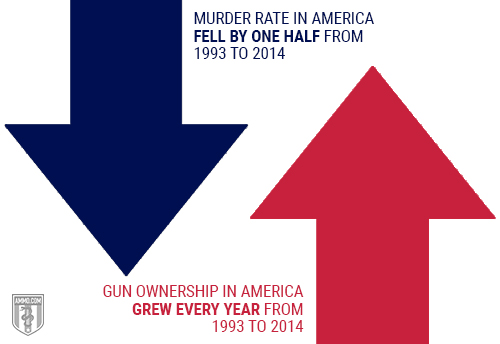
The British government will eventually have to admit that there’s only so much it can do to fight crime. Instead, the U.K. and Australia, for that matter, should follow in the footsteps of America and expand gun rights. The gun rights victories that have occurred since the 1980s have served America well.
Research from the Pew Center in 2015, showed that the murder rate in America fell by one half – 7 per 100,000 in 1993 to 3.4 per 100,000 in 2014. In the same period, the total number of gun deaths (numbers that include accidental deaths and suicides) dropped by almost one-third, plummeting from 15.2 to 10.6 per 100. Additionally, the number of privately owned guns and people carrying concealed has grown year by year.
Over the past three decades, gun laws have witnessed unprecedented levels of relaxation at the state level. From reforms such as licensed concealed carry to permitless Constitutional Carry, law-abiding gun owners in certain states have more firearms freedoms than in previous decades. These numbers at least demonstrate that looser gun laws don’t lead to chaotic episodes of violence. Crime rates don’t suddenly explode when people are allowed to freely own and carry firearms. The warnings of so-called Wild West scenes popping up left and right prove to be unfounded.
The Australian and British cases, on the other hand, show a more mixed picture of countries that were already safe before passing gun control due to political outrage. The effects of these laws are still being discerned, however, it can be argued that they have had little effect on impacting crime. In the British case, law-abiding citizens may want to have expanded gun rights due to the country’s increasingly unstable migrant crisis and the police’s inability to stop crime.
All in all, a truly free society is one that respects an individual’s right to self-defense. No matter the intentions, governments have no authority to infringe upon this sacred right.

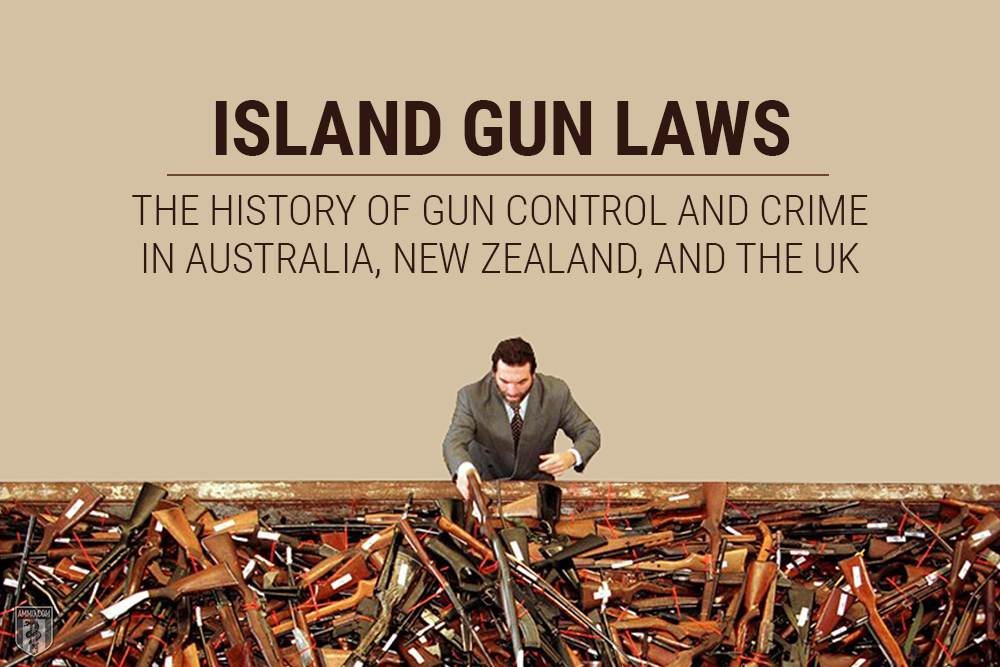















keep addressing this as guns that cause the problems instead of human mental health. I do know that when all the guns are gone, those that feel they are superior to the rest of humanity tend to become draconian and overly controlling as they implement their prescription for “a better life” (it always is for them)